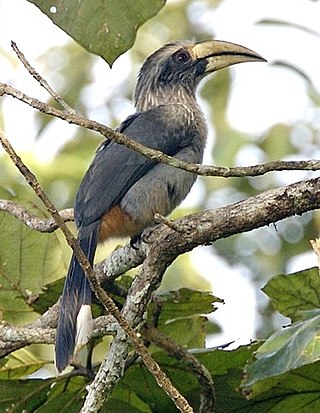
The Malabar gray hornbill is a hornbill endemic to the Western Ghats and associated hills of southern India. They have a large beak but lack the casque that is prominent in some other hornbill species. They are found mainly in dense forest and around rubber, arecanut or coffee plantations. They move around in pairs or small groups, feeding on figs and other forest fruits. Their loud cackling and laughing call makes them familiar to people living in the region.

Humayun Abdulali was an Indian ornithologist and biologist who was also a cousin of the "birdman of India", Salim Ali. Like other naturalists of his period, he took an initial interest in shikar (hunting). Unlike Sálim Ali, his main contributions were less field-oriented and based more on bird collections, particularly those at the Bombay Natural History Society where he worked for most of his life.
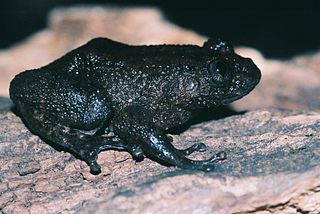
Nyctibatrachus is a genus of frogs endemic to the Western Ghats of southwestern India. Their common name is night frogs. Their scientific name also means "night frog", in reference to their habits and dark color. They are the only extant members of the monotypic subfamily Nyctibatrachinae. Currently, 35 species belong to Nyctibatrachus.

The Malabar gliding frog or Malabar flying frog is a rhacophorid tree frog species found in the Western Ghats of India.

Uperodon montanus, also known as Jerdon's narrow-mouthed frog, Jerdon's ramanella, mountain dot frog, mountain globular frog, or Malabar Hill frog, is a species of narrow-mouthed frog endemic to the Western Ghats of India.

Micrixalus saxicola is a species of frog in the family Micrixalidae, found in forest streams in the Western Ghats of India.This frog has a brown colored dorsum and a white ventral side with irregular white specks on its dark brown throat and chest. Its smooth skin and cryptic coloration allow it to blend into its surroundings while resting or calling. The males of the species are territorial, and will use calling, foot tapping, and foot flagging to warn off competition. M. saxicolais is described by the IUCN as a vulnerable species due to habitat loss, fragmentation, and human interference.The frog also threatened by infection by the fungus Batrachochytrium dendrobatidis.
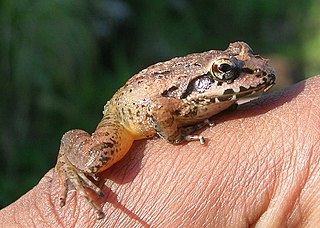
Indirana semipalmata is a species of frog endemic to the Western Ghats region of southern India. They are small frogs, reaching lengths of about 36 mm (1.4 in) from snout to vent. The species breeds during the monsoons, laying their eggs on moist rocks and tree bark. Their tadpoles are terrestrial - hatching, feeding, and undergoing metamorphosis without ever entering any standing bodies of water.
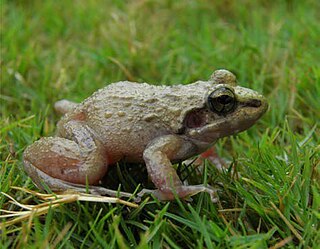
Indirana leithii is a species of frog in the family Ranixalidae. It is endemic to the northern Western Ghats of India. As currently defined, its range is restricted to the states of Maharashtra and southern Gujarat; earlier records elsewhere refer to other species.

Nymphargus grandisonae is a species of frog in the family Centrolenidae. It is found in Andes of Colombia and Ecuador. Its natural habitat is tropical moist montane forest ; larvae develop in streams and still-water pools. Its habitat is threatened by habitat loss, introduced fish, and agricultural pollution, but it is still a common species not considered threatened by the IUCN.
Nyctibatrachus aliciae is a species of frogs in the family Nyctibatrachidae endemic to the southern Western Ghats in Ponmudi and Athirimala in Kerala, India. These frogs occur in riparian habitats and in streams in tropical moist evergreen and semi-evergreen forests, tolerating some degree of habitat modification. The species, though locally common, has a small distribution are and is threatened by habitat loss.

Nyctibatrachus beddomii is a species of frog in the family Nyctibatrachidae. The epithet or specific name, beddomii, honors Colonel Richard Henry Beddome (1830-1911), British naturalist and military officer.
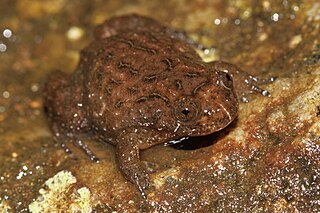
Nyctibatrachus deccanensis is a species of frogs in the family Nyctibatrachidae. It is endemic to the southern Western Ghats in Tamil Nadu and Kerala states, India. Its natural habitats are tropical moist lowland forests, moist montane forests, and rivers. It is threatened by habitat loss.

The giant wrinkled frog is a species of frogs in the family Nyctibatrachidae endemic to the Western Ghats of India in the Kudremukh region. Its natural habitats are tropical moist lowland forests and rivers. It is threatened by habitat loss.

The Kalakad wrinkled frog ) is a species of night frog in the family Nyctibatrachidae endemic to the Western Ghats, India. Its natural habitats are tropical moist lowland forests. It is threatened by habitat loss.
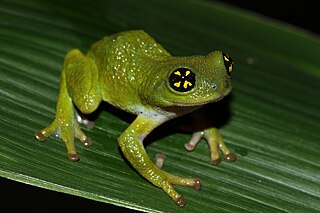
Raorchestes chalazodes is a species of critically endangered frog in the family Rhacophoridae. Raorchestes chalazodes is a nocturnal and arboreal species found in the understorey of tropical moist evergreen forest and is endemic to the Western Ghats of India. The specific name chalazodes is composed of the Greek word χάλαζα (chalaza) meaning "lump" and -odes for the derived adjective, reflecting white granulation of the body.
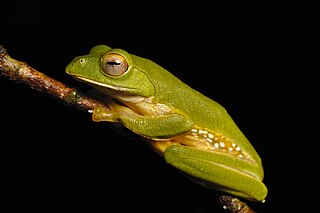
Rhacophorus pseudomalabaricus, also known as Anaimalai flying frog, false Malabar gliding frog, and false Malabar tree frog, is a species of frog in the family Rhacophoridae. It is endemic to the Anaimalai Hills, a part of the southern the Western Ghats in the Tamil Nadu and Kerala states, India.

The Himalayan flameback, also known as the Himalayan goldenback, is a species of bird in the family Picidae. At the moment very little is known of this species and more fieldwork is required. The Himalayan flameback is not threatened but it is suspected that deforestation could severely affect the species population.

The Dattatreya night frog is a species of frog in the family Nyctibatrachidae first described in the Shola forests around the Dattatreya Peeta in the Chikkamagaluru district of Karnataka. It is still known only from this part of the Western Ghats, India.
The Jog night frog or Jog's night frog is one of 12 species of nocturnal frogs in the genus Nyctibatrachus. It is found exclusively in the Western Ghats, India, and both sexes share the responsibility of watching over the eggs.
Papurana attigua is a species of frog in the family Ranidae, the "true frogs". It is found in central and south Vietnam, eastern Cambodia, and southern Laos. The specific name attigua is derived from Latin attiguus meaning "neighbor". It refers to the similarity of this species to Indosylvirana milleti. The common name similar frog has been coined for this species.


















